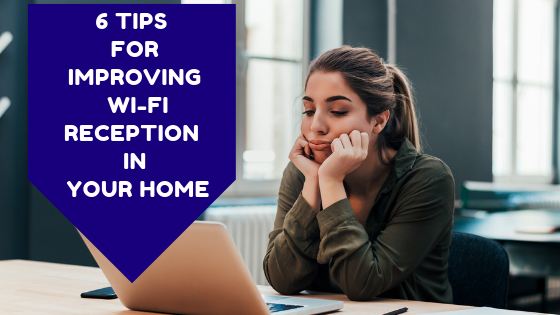We all use Wi-Fi almost every single day and so many of our modern devices rely on it to connect to the internet. Some of these include our phones, tablets, laptops, game consoles and smart home devices. Without Wi-Fi we would have cables everywhere in every room in our homes!
Wi-Fi is great, but sometimes Wi-Fi reception isn’t very strong and in some rooms in our homes, the signal is very weak. Luckily there are ways to fix this, here are 6 tips for improving Wi-Fi reception in your home.
1. Find out the range of your Router
Generally, most commercial routers have a Wi-Fi range from 10 meters to 30 meters, this could be more depending on the make and model of the router. If you have a large home, it is a good idea to check how far your router can actually send a signal before purchasing one. Or if you have already purchased a router, then knowing its range will help you to know where the best place to use your devices is. If you have rooms in your home where the distance is close to the edge of the router’s range, you may find that the devices you connect to it disconnect often as the signal struggles to reach there.
Conducting a speed test with a laptop, tablet or phone in your home in different rooms will give you a good idea of which room in your home has the best Wi-Fi reception.
2. Wi-Fi dropping out often? Consider restarting your router
At times you may have way too many devices connected to your router and it is struggling to keep everything connected and your Wi-Fi signal drops out for a while. Other times, the router can become frozen or get clogged trying to do too much. When this happens, the router’s system needs to be reset. To do this, you simply need to switch your router off for a minute or two, then switch your router back on. Then connect your device to your router’s Wi-Fi again and the signal should be much clearer with the router not connected to so many things and with whatever was clogging it up cleared during the reset process.
Additionally, Wi-fi dropping out may be due to the range that your router can reach. If this is the case, try moving your device closer to the router to see if the drop outs stop happening. If they do, then you may need a Wi-Fi extender or powerline adapter to reach into a far away room.
3. Look out for things which may block the Wi-Fi signal
Be on the lookout in your home for things which may block the Wi-Fi signal. Wi-fi signals are not very good at getting through microwaves, so putting your router behind one isn’t a great idea. Also if you have a large aquarium in your home and your PC is between that Aquarium and your router, then the signal is going to struggle getting through all of that water! The signal may still get through your microwave or aquarium, but it might be a little slower or have interference due to those objects being there.
Other things which can impact on Wi-Fi signals in your home are thick walls. Some people have stone walls in their homes and Wi-Fi signals don’t get through them at all. Large cupboards and large mirrors also can cause the signal to be weaker in some rooms.
You may still be able to get reception with all of these things in your house, but moving your devices or router into a position where these objects don’t block the signal will help you to get better reception. If you don’t want to move all your furniture around your home though just to get a good signal, you don’t need to, home networking accessories like mesh routers or powerline adapters may be useful. See our article on home networking here.
4. Think about your other wireless devices and what they’re doing
If you live in home with many connected devices and to be honest most of us do these days. Then it’s likely your router is going to be maintaining connections with many devices at the same time. Sometimes so many devices like this can result in signal interference, but it can also cause speed to slow down. If you have a family at home and two people are watching Netflix in separate bedrooms and then you would like to watch Netflix in the lounge room, but can’t because it won’t load. Then what’s happening here is that other devices are using up all the bandwidth that your router has available.
Some routers come with apps that allow you to prioritise certain devices over others. This will help to keep the signal strong for those devices. Some routers also have apps that allow you to disconnect certain devices at any time from within the app. But if your router does not have this, you may just need to go find your connected devices and manually disconnect them.
5. Update your software
Both your devices such as your PC, Phone or computer should frequently be updated to avoid any connection issue bugs that may be present in them. But more importantly, it is a good idea to also update your router’s firmware to the latest version. Not only is this good for security, but It can also help to keep your speeds steady and keep your router running as it should be.
6. Upgrade your home network
Sometimes, some people’s homes are just too large, their walls are too think and their furniture is massive. Having just one router in the house is just not going to do the job when it comes to reaching every room in the house and there will be dropouts and reception issues. To get around this, it’s a good idea to look into some home network accessories such as Wi-Fi extenders, powerline adapters or mesh router systems. See our article on home networking here to learn more about the different devices that are available to choose from.
There’s no need in 2019 to be having poor internet reception in your home and there are so many possibilities and things that can be done to keep the signal strong in every room in the house.




